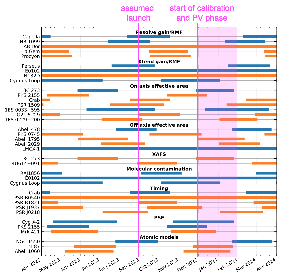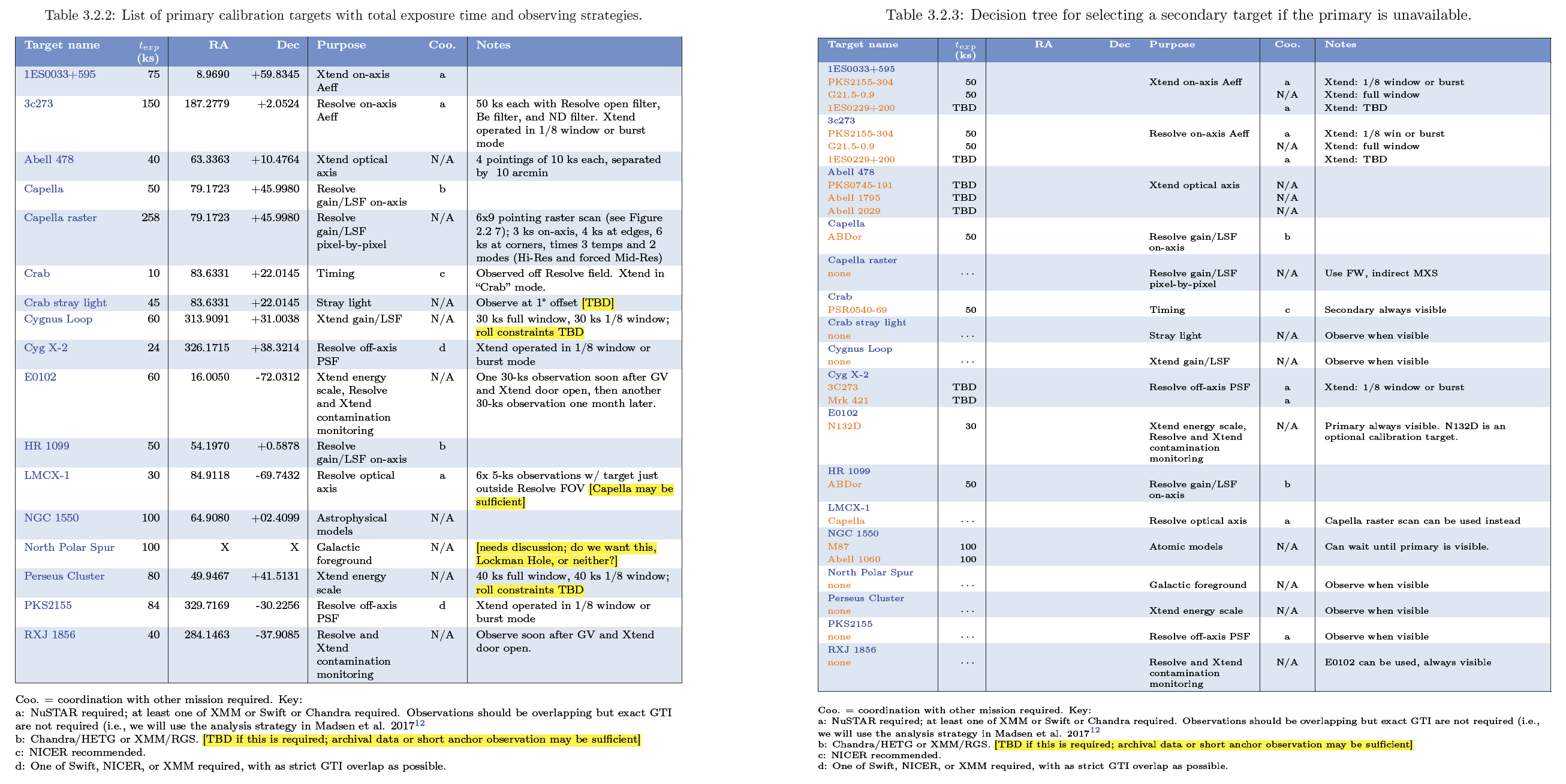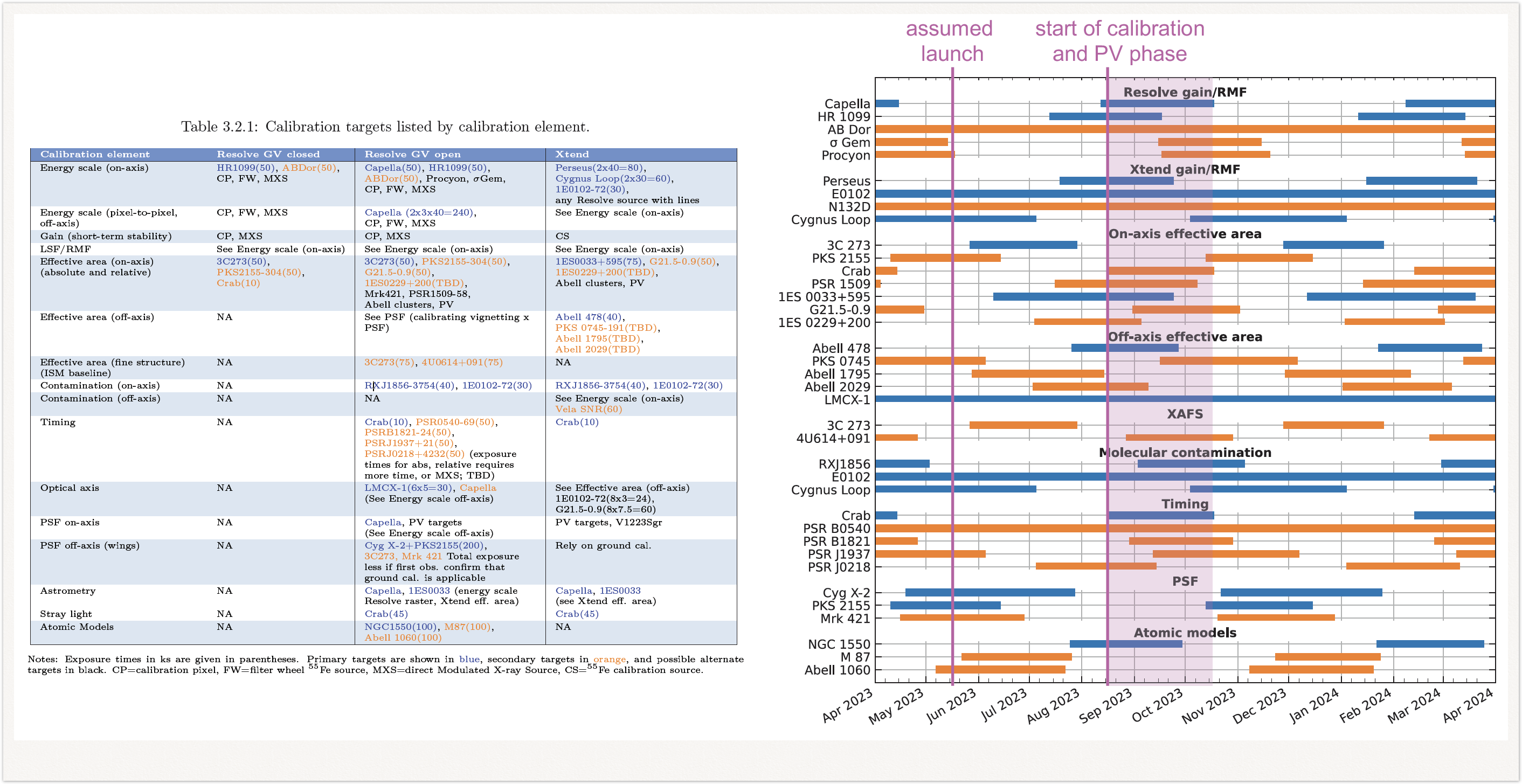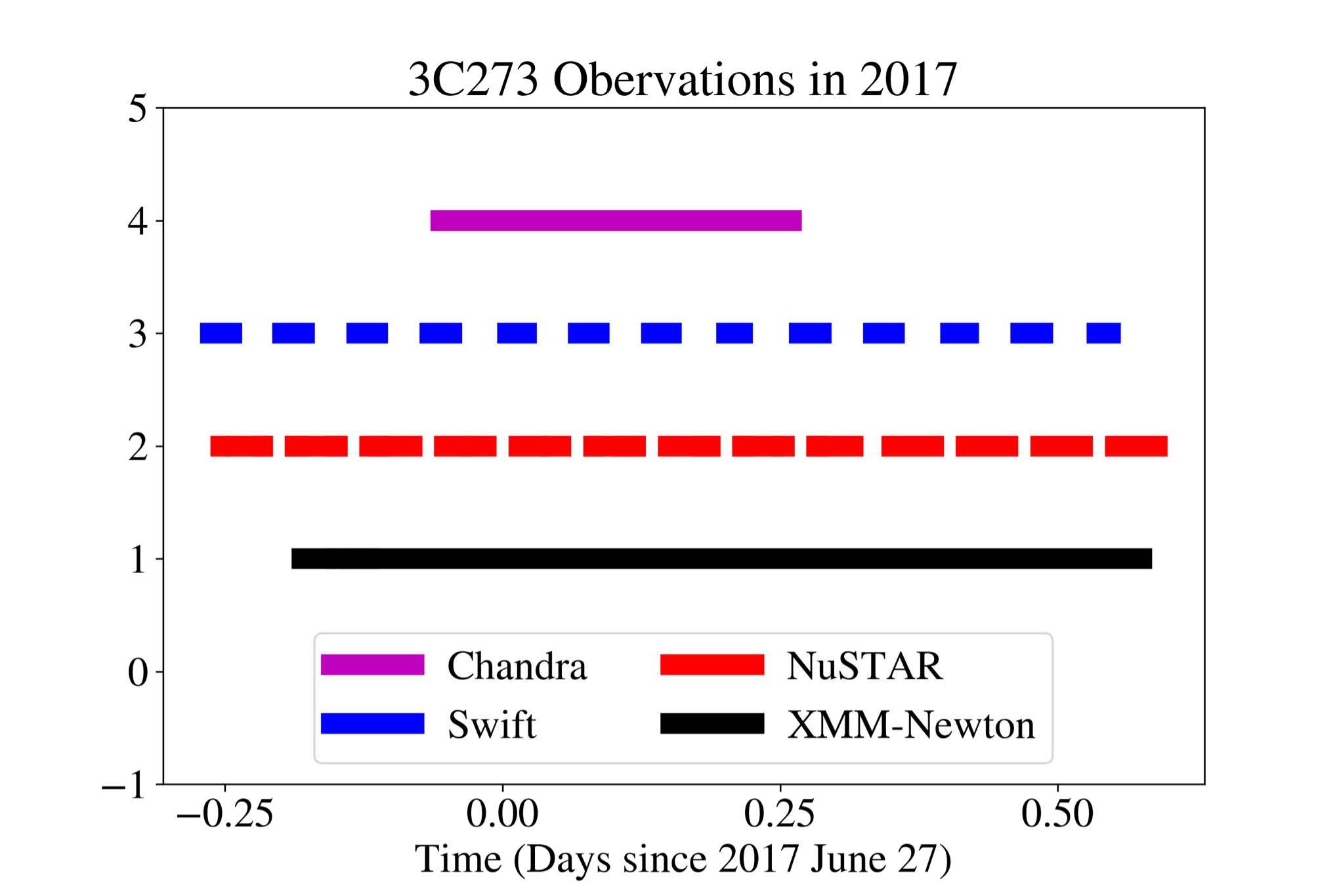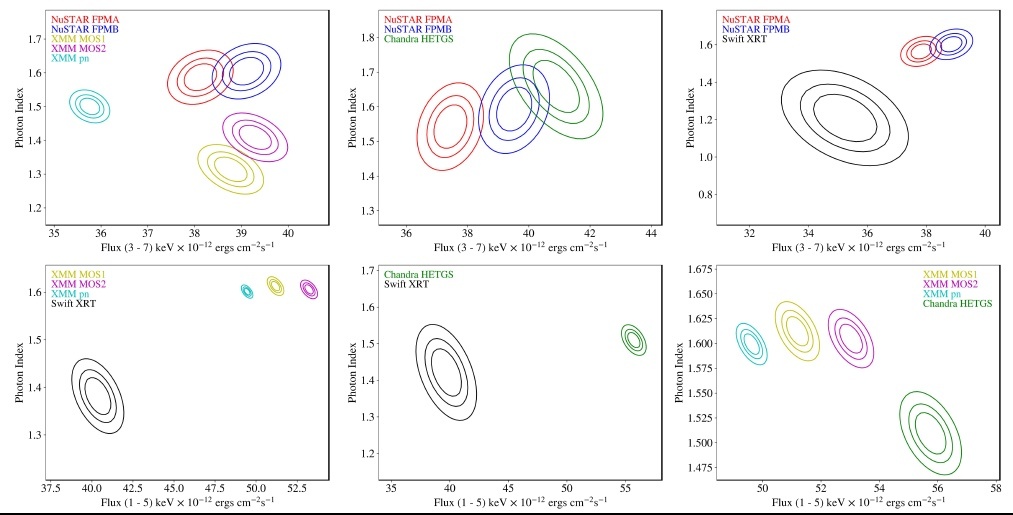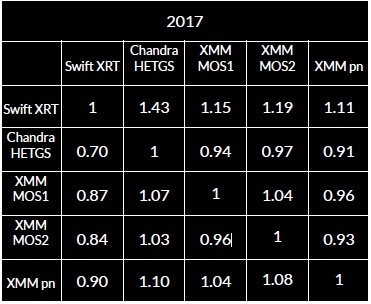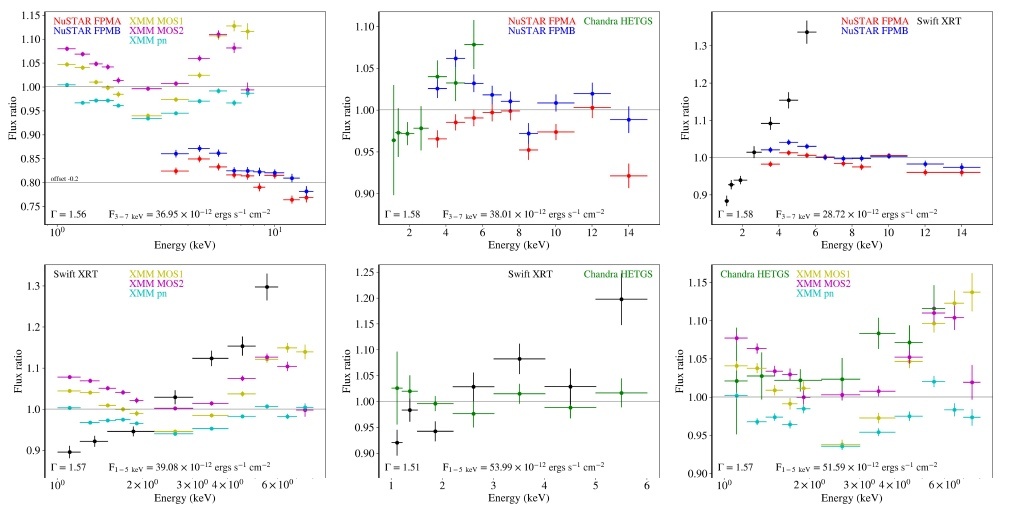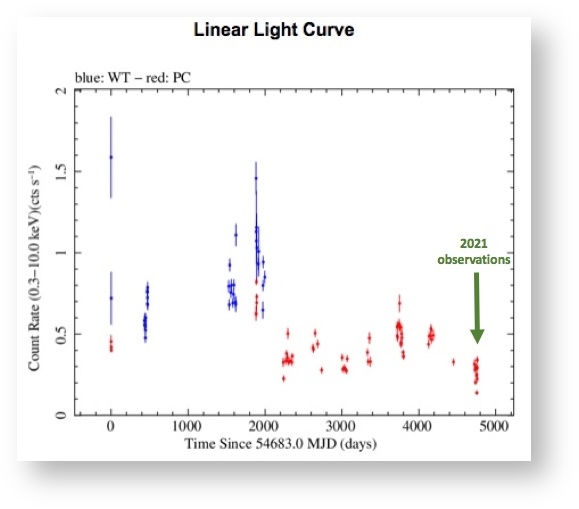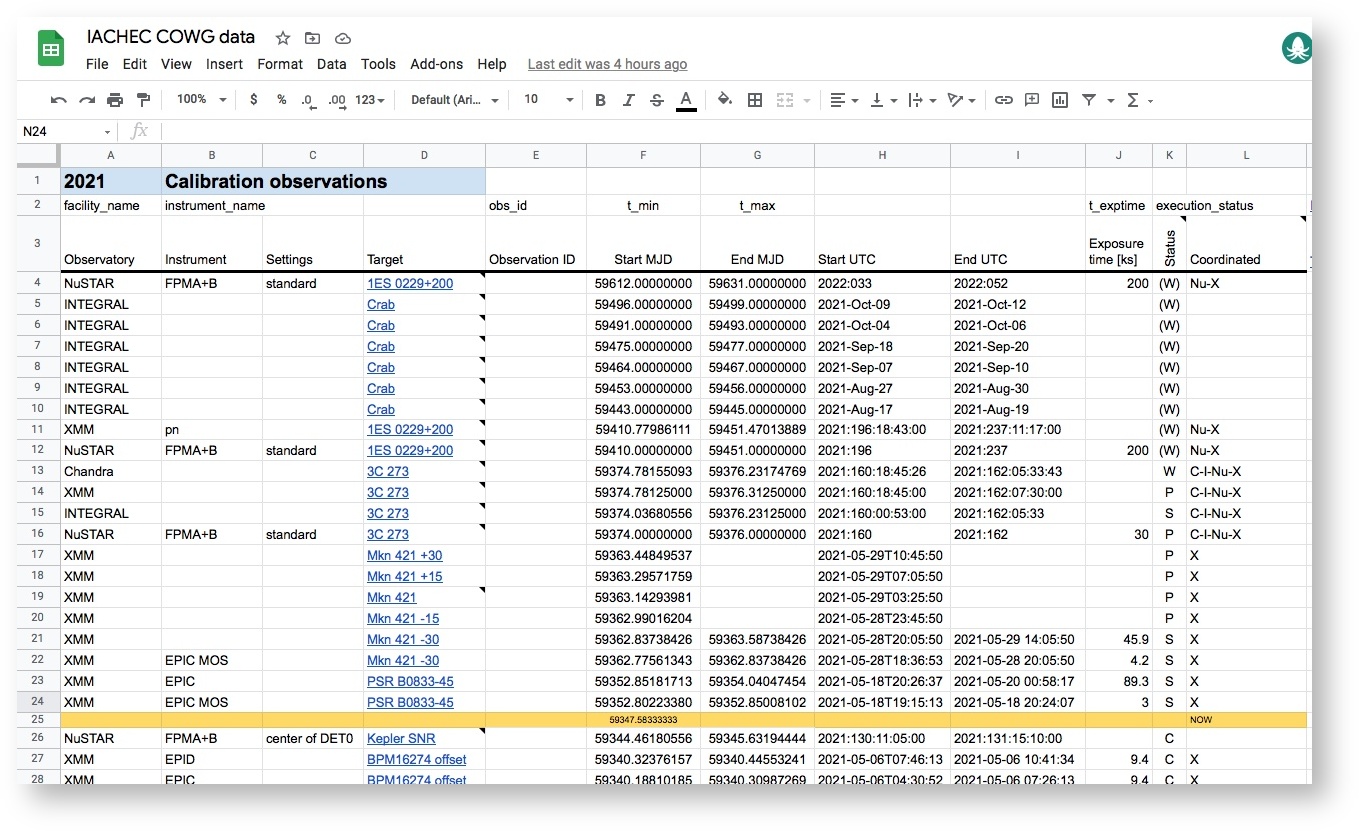...
This working group also supports additional opportunities for coordinated cross-calibration observations between observatories.
Activity
2021-10-22 - WG meeting on zoom
...
3C 273 coordinated observation
Within this working yearly coordinated calibration observations of the quasar 3C273 are organized. On this dedicated page we collect all information and data about those observations.
...
Activity
2023-05-14 - WG meeting at IACHEC meeting
2023-04-26 - WG meeting at IACHEC meeting
2023-02-10 - WG meeting on zoom
2021-10-22 - WG meeting on zoom
2021-05-18 - Chairs report at 2021 IACHEC Spring WG meeting 2021-05-18 - Chairs report at 2021 IACHEC Spring WG meeting is available here
2021-05-13 - WG meeting on zoom
...
2024 May 14th - Working group session at IACHEC meeting
...
| Observatory | Exposure time (ks) | ...and at other wavelengths | ||
|---|---|---|---|---|
| Astrosat | 160 LAXPC (40 ks UVIT) | ATOM | BVRI | |
| NICER | 45.9 | Effelsberg 100m | 2cm and 14mm bands | |
| NuSTAR | 107+65+63 | H.E.S.S | TeV 10 ks/day | |
| Swift | 20 | MAGIC | 30 GeV - 100 TeV | |
| XMM-Newton | 122.6 | |||
Crab
- Parador de la Granja
1800 to 1930 CEST (= 1600 to 1730 UTC)
in room 1 and on zoom (see email and slack channel for connection URL)
Presentations:
A NICER look at X-ray cross-calibration using 3C 273 - Jeremy Hare
First results on XRISM effective area cross-calibration - Eric Miller/Takayuki Hayashi
NASA’s Astrophysics Cross-Observatory Science Support (ACROSS) Pilot Project - Jamie Kennea
followed by discussions.
...
2023 April 26th - Working group session at IACHEC meeting
CoObs Working Group session - Wednesday April 26th at 4:20pm CEST
Zoom meeting link: https://caltech.zoom.us/j/84321299787
Meeting Time: 1420 UT | ||
|---|---|---|
4:20pm CEST (Germany, Local) | ||
7:20am PDT (Los Angeles) | 10:20am EDT (Philadelphia) | 3:20pm BST (Leicester) |
7:50pm IST (Mumbai) | 10:20pm CST (Beijing) | 11:20pm JST (Tokyo) |
Agenda
- IACHEC support for XRISM flight calibration
- Launch delayed, now no earlier than August 26th
- Pushes start of calibration observations to 2023-December
- 2023 IACHEC multi-mission calibration campaign of 3C 273
- move from June to December (or 2024 January)?
- Many targets will be observed by NuSTAR and XMM (and others?) during PV-Phase
- 2024 January to June
- 2024 January to June
- Launch delayed, now no earlier than August 26th
- IACHEC support for in-flight calibration of the Einstein Probe mission
- FXT telescopes (but also WXT?)
- Launch expected in November 2023
- Continued coordinated calibration support for high energy missions
- IXPE, HXMT, Astrosat, others?
- Coordinated observation planning and communications
...
2023 February 10th - Working group meeting
| Meeting Time: 1300 UT | ||
|---|---|---|
5am PST (Los Angeles) | 8am EST (New York) | 1pm GMT (Leicester) |
| 2pm CET (Madrid) | 6:30pm IST (Mumbai) | 10pm JST (Tokyo) |
Agenda
- XRISM calibration plans - Eric Miller
- coordinating observatory data availability / processing (PDF slides)
- XRISM scheduling - Chris Baluta
- communication paths between scheduling teams
- 2023 multi-mission coordinated calibration campaign (3C 273) - All
Documents for the meeting:
Eric's slides PDF
Draft XRISM in-flight calibration target schedule (case study assuming mid-May 2023 launch) Text File
Draft XRISM in-flight calibration target information. PDF
Notes from the meeting:
Attending (in alphabetical order): Lucia Ballo, Chris Baluta, Jacobo Ebrero, Karl Forster, Katsuhiro Hayashi, Elisabeth Jourdain, Michael Loewenstein, Renee Ludlam, Herman Marshall, Eric Miller, Lorenzo Natalucci, Jan-Uwe Ness, Katja Pottschmidt, Celia Sanchez, Michael Smith, Yukikatsu Terada, Stefan Wagner, Josh Wing,
XRISM calibration plans – Eric Miller (PDF slides)
- Presented plans requiring coordinated observations with other observatories
- see "Planning in-flight calibration of XRISM" E.D. Miller et al (2020) SPIE online paper
- Calibration targets are interesting science targets as well
- inclusion of the science team provides understanding of target idiosyncrasies
Timeline:
- First 3 months after launch is a commissioning phase, then:
- 1 month of in-flight calibration
- 6-months PV-phase with calibration observations scattered throughout
On-axis Absolute/Relative effective area calibration - requirement is 10% / 5% for both instruments on-axis
- Generally done with blazars (time variable), in particular 3C 273
- Mrk 421 is too bright for Resolve and 1ES 0229+200 is generally too faint, so although listed, they are not ideal targets
- Fainter targets are good for Xtend (stricter bright source limit compared to Resolve) e.g. 1ES 0033+595
- Simultaneous observations requested: E.g. annual 3C 273 IACHEC campaign (see below)
Timing requirement - 1ms at 1-sigma for highest spectral resolution events (for Resolve)
- Pulsar observation: Crab (primary), three secondary targets
- observations can wait for visibility (not required for PV-phase)
PSF calibration – observe bright sources off-axis and outside field of view
- Using PKS 2155-304 then Cyg X-2 for further outside FOV
- These are variable so request simultaneous coordinated observation
Energy scale and spectral response for each pixel - using raster scan observations of Capella
- Orbital variations (binary velocity) require coordinated observations with Chandra HETG during long XRISM observation
- No need for strict GTI overlap
Coordinated observations mission Points of Contact (PoC) for Calibration Scientists and Operations (scheduling) teams
Mission | Calibration PoC | Operations PoC |
|---|---|---|
IACHEC | Eric Miller | (Karl Forster) krl _at _ srl.caltech.edu |
Chandra | Paul Plucinsky | Josh Wing jwing _at_ cfs.harvard.educxc_coord _at _ cfa.harvard.edu |
NICER | Teruaki Enoto | NICER team nicer-sciplan _at _ bigbang.gsfc.nasa.gov |
NuSTAR | Katja Pottschmidt | Karl Forster krl _at_ srl.caltech.edu |
Swift | TBD | Jamie Kennea and Swift ops team swiftods _at _ swift.psu.edu |
XMM-Newton | Matteo Guainazzi | Lucia Ballo xmmpi _at _ sciops.esa.int |
XRISM | Eric Miller | Chris Baluta cbaluta20 _at _ gmail.com |
- Add possible coordinated observations with INTEGRAL - Eric M. will discuss with Erik Kuulkers and Celia Sanchez - ACTION
- Will need authorization from each coordinated observatory for each observation – ACTION
- Start the process before launch
- Also identify the team members that will analyze the data from the coordinating observatories – should be in place soon.
XRISM Calibration targets
- Some targets may be could be useful to observe during first month after launch when the Be gate valve is closed (absorbs all E < 2 keV and 50% E>2 keV)
Calibration targets with requested coordinated observations
Charts of target list and visibility plots (blue primary, orange secondary)
- Some targets could be useful for both Resolve and Xtend calibration (e.g. similar PSF’s)
- Calibration proposal documents will be made available (e.g. ½ page of details for each target)
ACTION - Plan to organize (multiple?) WG meetings during calibration campaign to discuss progress and any adjustments.
- Also to organize regular scheduling discussions - particularly during PV-phase where there may be many coordinated science observations
After PV-phase
- A plan is being developed by the XRISM instrument teams to determine routine calibration observations during the mission
- Likely to join annual IACHEC multi-mission campaign on 3C 273
- E.g. E0102 / Perseus cluster routinely observed for low / high energy calibration and contamination monitoring
XRISM scheduling process – Chris Baluta
- Determine contact information of schedulers – communication paths
- No planned observations yet for Chandra (need cycle-25 proposal or DDT request) - ACTION
- Weekly schedule upload to spacecraft
- Posted online ~3 weeks in advance
- Response time for ToO’s - minimum of 2 days (3 days for weekend)
Suggest delay of annual IACHEC multi-mission calibration from June 2023 to January 2024 - ACTION
- Chandra, XMM-Newton visibility is good up to 2023-01-14
- Will be discussed at April IACHEC meeting
...
2021 October 22nd - Working group meeting
| Observatory | Exposure time (ks) | ...and at other wavelengths | ||
|---|---|---|---|---|
| Astrosat | 160 LAXPC (40 ks UVIT) | ATOM | BVRI | |
| NICER | 45.9 | Effelsberg 100m | 2cm and 14mm bands | |
| NuSTAR | 107+65+63 | H.E.S.S | TeV 10 ks/day | |
| Swift | 20 | MAGIC | 30 GeV - 100 TeV | |
| XMM-Newton | 122.6 | |||
Crab
Coordinated observations by INTEGRAL, XMM-Newton, and NuSTAR continue with the goal of refining the NuSTAR and XMM-pn calibration. Observations coordinated with the IXPE schedule (currently 2022-02-21) are also planned.
- Kristin Madsen presented the analysis by Corin Marasco of the XMM-Newton, Chandra, NuSTAR, and Swift observations of 3C 273 that have been performed annually since 2015.
- This is an extension of the work presented in Madsen et al. (2017) AJ 153, 2 https://iopscience.iop.org/article/10.3847/1538-3881/153/1/2
- Joint fitting of the spectra from pairs of observations with matching Good Time Intervals were examined in bands:
- 3-7 keV for NuSTAR + Chandra/Swift/XMM-Newton pairs
- 1-5 keV for Chandra/Swift/XMM-Newton pairs
- Absorbed power-law model (zpow*cflux*tbabs) used to examine the measured flux relative to the model flux
- Example for 2017 observations:
Model parameters from the 2017 observations | |
Cross normalization constants from the pairs of observations are shown on the left. Note:
| |
- Communication with the Chandra team is underway to check the Chandra analysis
- The NuSTAR analysis will be redone with the updated calibration released this month (2021 October)
- NICER observations will also be folded into the analysis (Renee Ludlam)
- Analysis will be extended to evaluate within the concordance framework (arXiv)
- Flux ratio examined in narrow energy bands - model independent
- There is some complexity to the XMM spectrum - Felix Fuerst
- with correlated residuals between instruments
- Work is continuing and will include the 2021 XMM-Newton observations as well as the NICER observations.
NuSTAR observations of 1ES 0229+200 - Hannah Earnshaw (pdf)
- Three exposures obtained in August, 2021 (200 ks total)
- Compared to three short (~20 ks each) exposures obtained in 2013
- Spectrum can be modeled as an absorbed power law or a log-parabola continuum
- The source appears softer (gamma 2.03 -> 2.25) and fainter (about 25%) in the 2021 observations compared to 2013
- Even at historically low flux state the source is still sufficient for cross-calibration purposes
Swift-XRT monitoring of 1ES 0229+200
1ES 0229 with XMM-Newton and its impact on calibration - Felix Fuerst (pdf)
- 1ES 0229+200 observed on Oct 8-10, 2021
- 18.8 ks full frame exposure lost due to very bad background flaring
- Analysis of 60 ks small window EPIC-pn exposure presented
- can be modeled as an absorbed power law or cutoff power law
- Combined analysis with simultaneous 95 ks NuSTAR observation
- Fit improved with cutoff power law above 20 keV
- New NUSTAR calibration (CALDB20211020) improves agreement between NuSTAR FPM modules
- Analysis of joint XMM / NuSTAR observing campaign on the Crab was presented
- Observations performed every ~6 months
- Observations are used to create a correction functionfor EPIC-pn ARF
- Correction function will be vetted with more observations (calculated using MCMC)
- Analysis of joint observations of 3C 273 and 1ES 0229+200 indicate that EPIC-pn normalization is ~83% of (updated) NuSTAR FPMA
- Calibration update for EPIC-pn is being developed
- Power-law slope of 1ES 0229+200 will be evaluated with XMM-MOS+OM and Swift-XRT+UVOT data
Discussion
- It was noted that the new NuSTAR calibration appears to push the relative normalizations of XMM-pn and NuSTAR-FPM further apart
- Need to be careful to use similar extraction regions in analysis of Crab observations for cross-calibration purposes
- (extended source so observations at different epochs = different roll can sample different areas of the remnant)
- Chandra observations show spectral curvature
- however no improvement is seen when more complex models are used
Observation of 1ES 0229+200 with Astrosat - Sunil Chandra
- 1ES 0229+200 is a faint source for Astrosat-SXT, 74 ks exposure obtained in 2021 August
- Modeled as an absorbed power law
- Excess above 5 keV may be due to background and features below 0.5 keV may be residual calibration artifacts
- Astrosat-UVIT data is yet to be released
- There is also a previous observation by Astrosat (that may not be available yet)
Action Items:
- Jamie Kennea - will contact Andy B. to see if Swift-XRT 2021 data for 1ES 0229+200 will be analyzed - DONE
- Renee Ludlam - Will work with Felix F. on joint analysis of NICER observations of 1ES 0229+200 - DONE
The meeting concluded after a discussion about supporting IXPE in-flight calibration
- Launch scheduled for Dec 9th, 2021
- A preliminary long term plan is available at https://ixpe.msfc.nasa.gov/for_scientists/ltp.html
- There are many coordinated observations approved for scientific programs with INTEGRAL, XMM-Newton, NuSTAR, etc.
- Some may be useful for cross-calibration
...
2021 May 13th - Working group meeting
- Kristin Madsen presented the analysis by Corin Marasco of the XMM-Newton, Chandra, NuSTAR, and Swift observations of 3C 273 that have been performed annually since 2015.
- This is an extension of the work presented in Madsen et al. (2017) AJ 153, 2 https://iopscience.iop.org/article/10.3847/1538-3881/153/1/2
- Joint fitting of the spectra from pairs of observations with matching Good Time Intervals were examined in bands:
- 3-7 keV for NuSTAR + Chandra/Swift/XMM-Newton pairs
- 1-5 keV for Chandra/Swift/XMM-Newton pairs
- Absorbed power-law model (zpow*cflux*tbabs) used to examine the measured flux relative to the model flux
- Example for 2017 observations:
Model parameters from the 2017 observations | |
Cross normalization constants from the pairs of observations are shown on the left. Note:
| |
- Communication with the Chandra team is underway to check the Chandra analysis
- The NuSTAR analysis will be redone with the updated calibration released this month (2021 October)
- NICER observations will also be folded into the analysis (Renee Ludlam)
- Analysis will be extended to evaluate within the concordance framework (arXiv)
- Flux ratio examined in narrow energy bands - model independent
- There is some complexity to the XMM spectrum - Felix Fuerst
- with correlated residuals between instruments
- Work is continuing and will include the 2021 XMM-Newton observations as well as the NICER observations.
NuSTAR observations of 1ES 0229+200 - Hannah Earnshaw (pdf)
- Three exposures obtained in August, 2021 (200 ks total)
- Compared to three short (~20 ks each) exposures obtained in 2013
- Spectrum can be modeled as an absorbed power law or a log-parabola continuum
- The source appears softer (gamma 2.03 -> 2.25) and fainter (about 25%) in the 2021 observations compared to 2013
- Even at historically low flux state the source is still sufficient for cross-calibration purposes
Swift-XRT monitoring of 1ES 0229+200
2021 May 13th Working group meeting
Review status of working group
- The chair has been very quiet since the last IACHEC meeting in May 2019 (apologies).
- Membership is open to all and has 60 colleagues subscribed to the WG slack channel (#coordinated-obs)
- Cross-calibration observations on 3C 273 were coordinated (thanks to Josh W. for starting the ball rolling with Chandra constraints each year)
- 2019-07-02 to 03 - Chandra, INTEGRAL, NICER, NuSTAR, Swift, XMM
- 2020-07-06 to 07 - Chandra, INTEGRAL, NICER, NuSTAR, Swift, XMM
- Communications
- There were no strong opinions about how best to communicate between WG members. Currently:
- email chair (Karl F.) krl _at_ srl.caltech.edu
- Slack channel: iachec.slack.com
- an email list server (hosted by Caltech) may be set up by Karl F. depending on what the other WG’s think (particularly the communications WG).
- DONE - iachec-co-obs@lists.srl.caltech.edu is active
- There were no strong opinions about how best to communicate between WG members. Currently:
- Dissemination of observation scheduling information
- International standards for target visibility and observation schedules have been developed by a team at ESAC, see https://www.cosmos.esa.int/web/vovisobs_protocols/home
- A client using these standards (ObjVisSAP, ObsLocTAP) implemented for INTEGRAL, XMM-Newton, Chandra, and NuSTAR is active (TOBY), see http://integral.esa.int/toby/
- (just click on the Calculate button to get latest schedules)
- Observatories are joining the callobaration (GAIA, NOT, MAGIC, XRISM)
- All IACHEC observatories are encouraged to join
- See also SmartNet http://www.isdc.unige.ch/smartnet/index.php
- Information about calibration targets and upcoming observations collected in google sheets
A/I Request that WG chairs look at lists on the google sheets and make/suggest additions/corrections
2021 3C 273 Cross-calibration campaign
- Confirmed observations scheduled for 2021 June 9th to 11th with Chandra, INTEGRAL, NuSTAR, XMM
- Kristin M. is advising two SURF students this (2021) summer in analysis of 3C 273 data taken since 2015
| Mission | 2015 | (ks) | 2016 | (ks) | 2017 | (ks) | 2018 | (ks) | 2019 | (ks) | 2020 | (ks) | 2021 |
|---|---|---|---|---|---|---|---|---|---|---|---|---|---|
| Chandra | 2015-07-14 | 30 | 2016-06-27 | 30 | 2017-06-26 | 27 | 2018-07-04 | 30 | 2019-07-03 | 30 | 2020-07-06 | 29 | Y |
| INTEGRAL | 2015-07-13 | 150 | 2016-06-26 | 100 | 2017-06-26 | 175 | 2018-07-04 | 100 | 2019-07-02 | 100 | 2020-07-04 | 120 | Y |
| NICER |
| 2018-07-09 | 1.5 | 2019-06-30 | 38 | 2020-07-08 | 25 | ? | |||||||
| NuSTAR | 2015-07-13 | 49 | 2016-06-26 | 35 | 2017-06-26 | 35 | 2018-07-04 | 40 | 2019-07-02 | 49 | 2020-07-06 | 44 | Y |
| Swift | 2015-07-12 | 18 | 2016-06-26 | 40 | 2017-06-23 | 22 | 2018-07-14 | 17 | 2019-07-12 | 16 | 2020-07-16 | 18 | ? |
| XMM | 2015-07-13 | 72 | 2016-06-26 | 67 | 2017-06-26 | 67 | 2018-07-04 | 78 | 2019-07-02 | 69 | 2020-07-06 | 70 | Y |
- This will be an update to Madsen et al. (2017) AJ 153, 2 https://iopscience.iop.org/article/10.3847/1538-3881/153/1/2
- It has always been difficult for Astrosat to join because 3C 273 is at low declination
- 3C 273 is a good target for XMM-RGS but there is pileup for EPIC instruments
Additional cross-calibration opportunities
- NuSTAR / XMM-Newton observations of the Crab in 2020/22
- Leading to revised calibration expected in 2021
- Insight-HXMT will join in future observations - Lian T.
IACHEC Support for in-flight calibration of upcoming missions
- Launch planned for 2021 November 17th
- Science observations begin around mid-December
- Target Visibility will be 90 deg from the Sun +/- 25 deg
- For observatory verification plan to observe:
- Crab: Two half-day observations separated by about a week (due to telemetry limit)
- 1ES 1959+650: used to check alignments - good target for IXPE as it is close to NEP and not too bright or faint
A/I Begin scheduling discussions a few months before launch (discuss details at September IACHEC meeting?)
- From Herman M.
- May also use Cyg X-1 in observatory verification
- Must be careful not to perform observations that potentially step on goals of science investigations
- Other coordinations?
- Astrosat-CZTI - Dipankar B.
- Polarization seen in Crab data and possibly Cyg X-1
- However - energy range (>100 keV) not close to IXPE (< 10 keV) so cross-calibration is likely to be a science investigation
- Astrosat-CZTI - Dipankar B.
- Other polarization missions?
- POLSTAR - not launched
- polarlight - GPD
- Launch likely to be between Sep 2022 - Aug 2023
- Effective area calibration observations will need ~30 ks (or at least 20 ks of overlap with coordinating observatories)
- NuSTAR will be useful to be able to calibrate XRISM instruments up to (possibly) 25 keV
- GTI based simultaneous periods would only be possible for a short time (< 1 day) due to relative orbit precession
- so aim for overlapping start/stop coordinated scheduling of calibration targets
- Crab will be used to calibrate effective area of RESOLVE
The potential of 1ES 0229+200 for calibration - Norbert Schartel & Felix Fuerst
- Motivation - Calibration model differences between NuSTAR and XMM-pn - soft excess?
- Is this caused by dust on mirror (or loss of mirror shells)?
- Blazars are good calibration sources - flat spectra between 200 eV and 15 keV
- Hence 3C 273 - (Swift monitoring) but this is bright of some missions and may some complexities to spectrum in this energy range
- Mkn 421 is difficult to model SED
- 1ES 0229+200
- XMM-MOS1 and PN can be fit with very simple power law + absorption
- Good fit of Power-law extrapolated to UV-Optical (XMM-OM)
- Flux is ~ 20% of 3C 273 so exposure time allocation will be larger but this may avoid pileup in sensitive missions
- Conclusion - Unique chance to calibrate from UV to X-ray
- Caveat - Source is variable - blazer! see Swift monitoring - so would require ~simultaneous observations (within ~few days)
- Past XMM and NuSTAR observations (separated by years) does not show evidence for significant spectral change (but observed at different flux levels)
- Target is not bright enough for INTEGRAL calibration observation
- For Swift the target may be too bright for PC-mode (pileup) but too faint for WT-mode - Jamie K.
- XMM + NuSTAR observations planned for 2021 July-August
- Swift observations will be requested - maybe multiple to examine variability
- Will ask for Swift-UVOT UV filters for cross-check calibration of XMM-OM
- TeV observatories HESS, MAGIC, and VERITAS have indicated they may join the campaign (likely with radio coverage)
- We encourage all missions to join cross-calibration campaign
- Swift observations will be requested - maybe multiple to examine variability
...
Attachments:
| Attachments |
|---|
